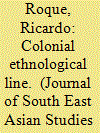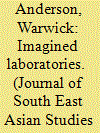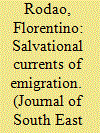|
|
|
Sort Order |
|
|
|
Items / Page
|
|
|
|
|
|
|
| Srl | Item |
| 1 |
ID:
161451


|
|
|
|
|
| Summary/Abstract |
The United States’ occupation of the Philippines began with proclamations of a new era of development and the prospect of local political representation. In coming to grips with what they saw as America's civilising mission, colonial scholars and officials sought information about the peoples of the Philippines by conducting a census and various population studies, using an array of methodologies drawn from criminology and physical anthropology. This article traces and critiques representations of the Philippine population in the 1903 Philippine Census as well as in several related studies published in the early American period, which served to reduce the Filipinos to a state of ‘otherness’ which served to justify colonial projects. Several of these racialised studies used the inmates of Bilibid Prison, both alive and dead, as experimental and documentary subjects to create a record of Filipino ‘sample types’ for various administrative and other purposes, such as the exhibition at the St Louis World's Fair of 1904. Bilibid prisoners’ body size, brain weight, skin colour, facial features and other physical attributes were selectively correlated with other colonial constructions of Filipino individuals and groups, such as ‘wildness’ and political maturity.
|
|
|
|
|
|
|
|
|
|
|
|
|
|
|
|
| 2 |
ID:
161452


|
|
|
|
|
| Summary/Abstract |
This article examines the connected histories of racial science and colonial geography in Island Southeast Asia. By focusing on the island of Timor, it explores colonial boundaries as modes of arranging racial classifications, and racial typologies as forms of articulating political geography. Portuguese physical anthropologist António Mendes Correia's work on the ethnology of East Timor is examined as expressive of these productive connections. Correia's classificatory work ingeniously blended political geography and racial taxonomy. Between 1916 and 1945, mainly based on data from the Portuguese enclave of Oecussi and Ambeno, he claimed a distinct Malayan racial type for the whole colony of ‘Portuguese Timor’. Over the years he developed an anthropogeographical theory that simultaneously aimed to reclassify East Timor and to revise the racial cartography of the Malay Archipelago, including Wallace's famous ethnological line.
|
|
|
|
|
|
|
|
|
|
|
|
|
|
|
|
| 3 |
ID:
161450


|
|
|
| 4 |
ID:
161455


|
|
|
|
|
| Summary/Abstract |
In the 1920s and 1930s, the Mestizos of Kisar, a dry, almost barren island in the Dutch East Indies off the coast of East Timor, were a model for the study of race mixing or human hybridity. Discovered in the late nineteenth century, these ‘anomalous blondes’ of Dutch and Kisarese ancestry became subjects of intense scrutiny by physical anthropologists. As a German specialist in tropical medicine in search of a convenient empire after 1918, Ernst Rodenwaldt favourably evaluated the physique and mentality of the isolated, fair Mestizos in the Dutch East Indies (now Indonesia). Back in Germany in the 1930s, as professor of hygiene at Heidelberg, his views on race hardened to accord with Nazi doctrine. Yet after the war, Rodenwaldt successfully cited his earlier appreciation of mixed-race peoples in the eastern Malay Archipelago as grounds for rehabilitation. Once a celebrated case study in human hybridity, the Mestizos of Kisar were erased from anthropological discussion in the 1950s, when race mixing ceased to be a biological issue and became instead a sociological interest. Still, Rodenwaldt's work continues to exert some limited influence in the eastern parts of the archipelago and among the Kisarese diaspora, indicating the penetrance and resilience of colonial racialisation projects.
|
|
|
|
|
|
|
|
|
|
|
|
|
|
|
|
| 5 |
ID:
161453


|
|
|
|
|
| Summary/Abstract |
This article explores how the islands of Bali and Lombok were racialised through the work of Dutch racial scientist J.P. Kleiweg de Zwaan in the 1930s. An examination of both Kleiweg's published works and his local practices draws attention to the fact that racialisation occurred at different moments of anthropological work, producing different outcomes. The article concludes that anthropologists communicated different versions of racial ideas to international academics and to local communities. The Bali-Aga and Sasak, who were measured, described and photographed by anthropologists, appropriated racial categories which they found meaningful.
|
|
|
|
|
|
|
|
|
|
|
|
|
|
|
|
| 6 |
ID:
161454


|
|
|
|
|
| Summary/Abstract |
This article analyses the changing significance of racial theories in the writings of Spanish emigrants in the late nineteenth century Philippines. Works by Antonio Cañamaque, Pablo Feced (Quioquiap), and Antonio Barrantes show how racialised understandings of colonial society in the Philippines evolved, from an initial dismissal of hybridism and rejection of mestizos to assertions of the innate superiority of the ‘white race’ and advocation of a rigid separation between local communities. These developments are considered in the context of the rising popularity of biological determinism alongside an influx of Spanish emigrants into the Philippines. The Spanish settlers used biological determinism to proclaim their role as the sole purveyors of both ‘progress’ and of a kind of egalitarianism. This article describes these debates and arguments, analyses their inconsistencies, and addresses the Filipino elite's responses to the settlers’ racial theories. These responses are read not simply as part of the development of Filipino nationalism, but as reflective of rivalries within the Spanish colonial community in the Philippines, where the locally born found additional reasons to support anticolonialism.
|
|
|
|
|
|
|
|
|
|
|
|
|
|
|
|
|
|
|
|
|